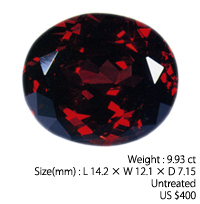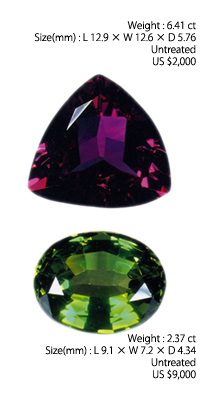TYPES OF GARNETS
There are many reddish garnets, but garnet may also be orange, yellow, green, or virtually any color other than blue. The different garnets vary in composition, refractive index, and hardness, and they belong to different mineralogical classifications. Here we will consider the garnets that are most commonly seen in the marketplace: almandite, rhodolite, and grossularite. Rhodolite is mined in Tanzania, Sri Lanka, and India, but there are no major differences in characteristics by county of origin.
|
 |
Almandite Garnet
Almandite has a red-brown color that resembles a dark ruby. Its major sources are Mozambique and Madagascar, but it is also reportedly found in Sri Lanka, Burma, India, Brazil, and Australia. Almandite is produced in large qualities and is generally sold in low-cost jewelry. |
|
Rhodolite Garnet
Of all the garnets, rhodolite is currently attractive the most attention. When comparing gem qualities of almandite, pyrope, and rhodolite, one notices the purplish color, high level of transparency, and fine brilliance of rhodolite. Some rhodolite lack beauty due to a color that is too dark, but these should be thought of as accessory quality. Because the quality of gemstones can cover a wide range, it can help to think in terms of gem quality, jewelry quality, and accessory quality when making a purchase decision. |
 |
Grossularite Garnet
Grossularite garnet with a beautiful, clear green color is called “tsavorite” in the United States. Discovered in 1968 in the Tsavo National Park in Kenya, it has been promoted by Tiffany’s under that name. The attractive green of tsavorite has been compared to that of emerald, but this gemstone’s drawback is that it is produced in small quantities. The limited popularity of grossularite can be understood when compared to diamond, which gained widespread acceptance largely due to a constant supply in sufficient quantities for it to find its way to many people. |
|
 |
JUDGING QUALITY
The quality of rhodolite is judged by its purplish red color, high level of transparency, and medium tone. The red in rhodolite is different from the red in ruby. Purplish red is not desirable in a ruby, but it is the most important consideration in the beauty of a rhodolite. Regarding transparency, a rhodolite should have few needle-like inclusions, and the material should not have a silky or cloudy appearance. A deep red rhodolite will lose its beauty if it is too dark. A rhodolite of gem quality will have a medium tone of purplish red, with high transparency and a good shape and appearance.
Stones that are too dark (tone 7), brownish stones, and stones with poor transparency will get a beauty grade of B, and are considered accessory quality. Stones with a tone of 3 are light because of a shallow cut; the tone of the material itself is actually darker.
As when viewing other reddish gemstones, it is especially important to judge the quality of a rhodolite while observing the stone under natural light.
|
| |
|